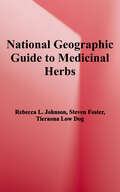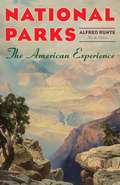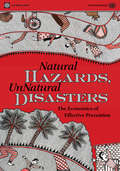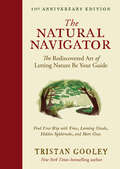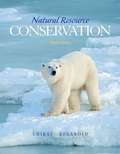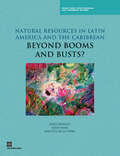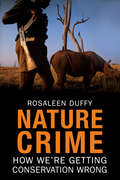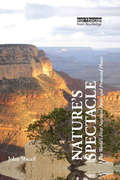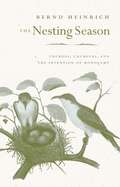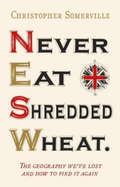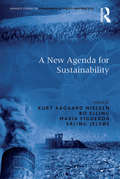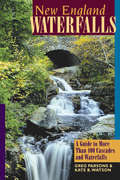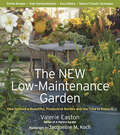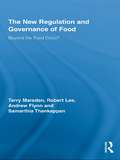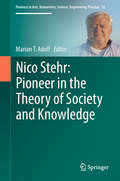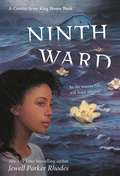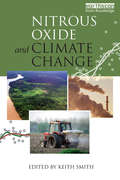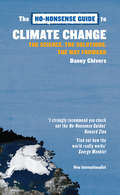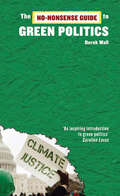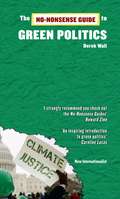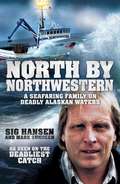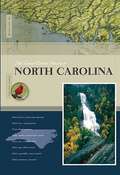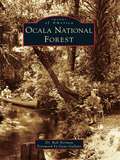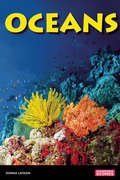- Table View
- List View
National Geographic Guide to Medicinal Herbs: The World's Most Effective Healing Plants
by Rebecca L. Johnson Steven Foster Tieraona Low Dog"This excellent guide is the work of a team of highly qualified botanical and medical experts, including two of my colleagues from the Arizona Center for Integrative Medicine. It offers reliable, up-to-date, practical information about 72 of the most important medicinal herbs." --Andrew Weil, M.D., from the Foreword. There is a world of health and healing all around you--in your spice rack, your backyard, and on the shelves of health food and grocery stores. This informative guide is a reference you will keep at the ready, connecting 72 of the world's most common and useful medicinal herbs with the body systems they help and heal.Eight chapters focus on body systems:1. Mental Health & the Nervous System2. Respiratory System3. Heart & Circulation4. Digestive System5. Joints, Muscles & Skin6. Urinary & Male Health7. Female Health8. Wellness & PerceptionEach chapter begins with an overview of how plants can bring health to that part of the body, with stories about traditional herbal remedies from around the world and current scientific findings on herbal remedies for specific illnesses. Then each chapter highlights nine plants, combining botanical and medical information--therapeutic uses, effectiveness, preparations, cautions, and advice, including a round-up of current science about the active ingredients in the plant. Every chapter includes a photo gallery showing how one of its herbs is cultivated and processed commercially--the story behind the contents of that bottle you buy in the store. Special features include "Over the Kitchen Counter"--quick and easy ways to use herbs in your everyday life, and time lines for every herb, showing how today's use of herbal remedies collects wisdom from the centuries and around the world. A functional appendix includes an illustrated index to all the plants in the book, an ailment-by-ailment therapeutic index, a glossary, and an index.
National Parks: The American Experience
by Alfred RunteThe National Parks: America's Best Idea," Alfred Runte is renowned as the nation's leading historian on the meaning and management of these treasured lands. Lavishly illustrated with period photographs, including eight pages of color paintings, National Parks: The American Experience has never been more beautiful or profound. This remains a stirring look into the lands that define America, from Yosemite and Yellowstone to wilderness Alaska.
Natural Hazards, UnNatural Disasters: Effective Prevention Through the Economic Lens
by World BankEarthquakes, droughts, floods, and storms are natural hazards, but unnatural disasters are the deaths and damages that result from human acts of omission and commission. Every disaster is unique, but each exposes actions-by individuals and governments at different levels--that, had they been different, would have resulted in fewer deaths and less damage. Prevention is possible, and this book examines what it takes to do this cost-effectively. It looks at disasters primarily through an economic lens. Economists emphasize self-interest to explain how people choose the amount of prevention, insurance, and coping. But lenses can distort as well as sharpen images, so the book also draws from other disciplines: psychology to examine how people may misperceive risks, political science to understand voting patterns, and nutrition science to see how stunting in children after a disaster impairs cognitive abilities and productivity as adults much later. Peering into the future, it shows that while urbanization and climate change will increase exposure to hazards, vulnerability can be reduced if cities are better managed. This book will be of interest to government officials, urban planners, relief agencies, NGOs, donors, and other development practitioners.
The Natural Navigator, Tenth Anniversary Edition: The Rediscovered Art Of Letting Nature Be Your Guide (Natural Navigation #0)
by Tristan GooleyFrom the New York Times-bestselling author of How to Read a Tree and The Lost Art of Reading Nature’s Signs, rediscover nature by noticing the hidden clues all around you “A truly vital book for any outdoor adventurer.”—Cabin Life Before GPS, before the compass, and even before cartography, humankind was navigating. A windswept tree, the depth of a puddle, or a trill of birdsong could point the way home, and they still do—if you know how to look. With The Natural Navigator, his first book, Tristan Gooley invited us to notice the directional clues hidden all around: in the sun, moon, stars, clouds, weather patterns, lengthening shadows, changing tides, growing plants, and habits of wildlife. A decade after publication, this modern classic still reminds us that we can find south by joining the horns of the crescent moon—and find adventure in our own backyards.
Natural Resource Conservation: Management For A Sustainable Future
by Daniel Chiras John ReganoldThis comprehensive book describes the ecological principles, policies, and practices required to create a sustainable future. It emphasizes practical, cost-effective, sustainable solutions to these problems that make sense from social, economic, and environmental perspectives. A focus on sustainable development puts readers in touch with one of the most significant shifts in thinking and action in the environmental and resource management arenas. A variety of lasting solutions are provided that make sense from social, economic, and environmental viewpoints.
Natural Resources in Latin America and the Caribbean: Beyond Booms and Busts?
by Augusto De la Torre Emily Sinnott John NashPolicy makers in many countries in the Latin American and Caribbean region have found it challenging to determine how to treat natural resource commodity production and how to manage the recurrent cycles of booms and busts. 'Natural Resources in Latin America and the Caribbean: Beyond Booms and Busts?' addresses the major concerns associated with commodity dependence, summarizing the state of the art in existing literature and filling in the knowledge gaps with new analysis. The report finds that some commonly accepted negative effects of dependence on natural resources are largely myths, while some are realities. But the authors find that all the effects can be managed, and they provide practical advice on how to do so. Issues covered include long-term fiscal growth, fiscal volatility, institutional impacts, and environmental and social effects. The report analyzes the implications for the region's development and policies. 'Natural Resources in Latin America and the Caribbean: Beyond Booms and Busts?' will be of interest to policy makers, academics, and analysts, as well as others interested in the economics of commodity markets and their role in economic development.
Nature Crime
by Rosaleen DuffyIn this impressively researched, alarming book, Rosaleen Duffy investigates the world of nature conservation, arguing that the West's attitude to endangered wildlife is shallow, self-contradictory, and ultimately very damaging. Analyzing the workings of the black-market wildlife industry, Duffy points out that illegal trading is often the direct result of Western consumer desires, from coltan for cellular phones to exotic meats sold in London street markets. She looks at the role of ecotourism, showing how Western travelers contribute--often unwittingly--to the destruction of natural environments. Most strikingly, she argues that the imperatives of Western-style conservation often result in serious injustice to local people, who are branded as "problems" and subject to severe restrictions on their way of life and even extrajudicial killings.
Nature's Spectacle: The World's First National Parks and Protected Places
by John SheailNational parks have always been an emotive and iconic symbol, ever since the first parks of the modern era were created in the mid-nineteenth century. This book, based on original research, delves deeply into their character and significance, and the larger context in which they developed. The book celebrates the deserved attractiveness of the parks as wilderness or 'spectacle' to millions of visitors, but also emphasises how there was nothing inevitable, self-sustaining or without cost in their magnificence and accessibility. Those early parks were a powerful unifying force as national 'playgrounds', especially as motor transport democratised their use. However they also provoked bitter conflict in their dispossession of local communities and perhaps deliberate segregation of people from scenery and wildlife. That first century of national parks, which concluded with the significant break of the Second World War and the subsequent development of more international approaches to conservation, left an uncertain legacy. It was a fragile foundation from which to build what became an integral part of today's conservation movement.
The Nesting Season: Cuckoos, Cuckolds, and the Invention of Monogamy
by Bernd HeinrichWhy are the eggs of the marsh wren deep brown, the winter wren's nearly white, and the gray catbird's a brilliant blue? And what in the DNA of a penduline tit makes the male weave a domed nest of fibers and the female line it with feathers, while the bird-of-paradise male builds no nest at all, and his bower-bird counterpart constructs an elaborate dwelling? These are typical questions that Bernd Heinrich pursues in the engaging style we've come to expect from him supplemented here with his own stunning photographs and original watercolors. One of the world's great naturalists and nature writers, Heinrich shows us how the sensual beauty of birds can open our eyes to a hidden evolutionary process. Nesting, as Heinrich explores it here, encompasses what fascinates us most about birds from their delightful songs and spectacular displays to their varied eggs and colorful plumage; from their sex roles and mating rituals to nest parasitism, infanticide, and predation. What moves birds to mate and parent their young in so many different ways is what interests Heinrich and his insights into the nesting behavior of birds has more than a little to say about our own.
Never Eat Shredded Wheat: The Geography We've Lost And How To Find It Again
by Christopher SomervilleDo you remember using the mnemonic Never Eat Shredded Wheat to remember the compass directions?<P> Bognor Regis...Aberystwyth...Glasgow...Can you place them on a map? Most people can't these days. What kind of countryside do you pass through on your way to the Cairngorms, or the Fens, or Northumberland? What's north of the Pennines? And what's it like when you get there? Most folk wouldn't have a clue. Increasing numbers of us don't have a basic geographical notion of these islands. Blame it on a decline in formal geography teaching, or Sat-Nav and other 'A to Z and nothing in between' devices that make us lazy -- we are becoming the best travelled and least well orientated Britons ever seen. <P> Now Christopher Somerville, bestselling author of Coast and many other books of UK exploration, presents the basics of what belongs where, which counties border one another, and what lies beyond the Watford Gap. He reminds us of the watery bits, the lumpy bits and the flat bits, and gets to grips with the smaller islands surrounding Britain -- and much more. Never Eat Shredded Wheat is a reminder of all the fascinating British geography once learned at school - geography that brings our islands vividly to life - geography which we have forgotten, or never even knew.
Never Eat Shredded Wheat
by Christopher SomervilleBognor Regis...Aberystwyth...Glasgow...Can you place them on a map? Most people can't these days. What kind of countryside do you pass through on your way to the Cairngorms, or the Fens, or Northumberland? What's north of the Pennines? And what's it like when you get there? Most folk wouldn't have a clue. Increasing numbers of us don't have a basic geographical notion of these islands. Blame it on a decline in formal geography teaching, or Sat-Nav and other 'A to Z and nothing in between' devices that make us lazy -- we are becoming the best travelled and least well orientated Britons ever seen. Now Christopher Somerville, bestselling author of Coast and many other books of UK exploration, presents the basics of what belongs where, which counties border one another, and what lies beyond the Watford Gap. He reminds us of the watery bits, the lumpy bits and the flat bits, and gets to grips with the smaller islands surrounding Britain -- and much more. Never Eat Shredded Wheat is a reminder of all the fascinating British geography once learned at school - geography that brings our islands vividly to life - geography which we have forgotten, or never even knew.
A New Agenda for Sustainability (Routledge Studies in Environmental Policy and Practice)
by Bo Elling Erling JelsøeTwo decades after the Brundtland Commission's Report "Our Common Future" adopted the concept of 'sustainable development', this book provides a renewal of the concept exploring the potential for new practices and fields for those involved in sustainability activity. The book addresses a number of themes concerning firstly, the provision of a "next generation perspective", which was a central, and still unresolved, notion of the original Brundtland definition and, secondly the provision of new milestones for policy and research that can expand the discussion on this second generation concept on sustainability. The material dealt with in the book offers a wide variety of perspectives on sustainability and reflects the importance of interdisciplinary and transdiciplinary work in the field. Suggesting targets for future analytical and political efforts in achieving global sustainability, this book offers new analytical opportunities for holistic politics and research at a general and sector level.
New England Waterfalls: A Guide to More Than 400 Cascades and Waterfalls (Second Edition)
by Kate B. Watson Greg ParsonsContains more than 400 waterfalls and many of the best swimming holes in New England. Whether hiking, fishing, skiing, or kayaking, Greg Parsons and Kate Watson have enjoyed experiencing water in all its various forms. But the form that has continuously fascinated them is the rarest and most beautiful one water can take: the waterfall. Full of allure and majesty, waterfalls are dramatic demonstrations of how the landscape changes over time. This greatly expanded edition describes more than 200 new waterfalls and provides extensive trail and road updates. Waterfalls throughout each of the New England states are described according to type, height, trail length and difficulty, water source, and the ideal seasons to visit. They are also rated for their inherent beauty so you can decide how best to spend your time. Chapters are organized by state, and each includes a map to help you easily identify other waterfalls nearby. With special appendixes of the best swimming holes, multi-waterfall day trips, and long-distance waterfall hikes, New England Waterfalls delivers a wealth of information for seekers of these regional treasures.
The New Low-Maintenance Garden: How to Have a Beautiful, Productive Garden and the Time to Enjoy It
by Valerie Easton Jacqueline Knox Jacqueline M. KochDo you ever lament that you'd love to be able to garden more, but just don't have the time? The demanding pace of modern life leaves little space for the pleasures of gardening. On the other hand, gardening itself could be the culprit: elaborate, traditional perennial borders; water-hungry or disease-prone plants; needy lawns; and high-maintenance plants that require staking or clipping all suck up precious hours. Simply put, we need to start gardening in a whole new way. In this inspiring book, Val Easton shows exactly how to have a low-maintenance garden that doesn't sacrifice style. You won't have to give up your favorite plants or settle for expanses of ugly bark nuggets. You just have to unlearn some bad old habits and pick up some good new ones. So, how do you go about making a "new" low-maintenance garden? First, design your garden with maintenance in mind—good-looking hardscape will both save weeding time and showcase your favorite plants. Second, simplify your garden routines—learn the most efficient planting and maintenance techniques and don't get stressed if everything isn't letter-perfect. Third, learn how to work with nature rather than against it. And finally, embrace home-grown fruits, herbs, and vegetables; well planted containers; and thoughtfully chosen plants.The New Low-Maintenance Garden doesn't just tell you how to garden in a whole new way—it shows you, through profiles and beautiful photographs of real gardens that embody low-maintenance techniques. The pressures of life are not likely to ease up anytime soon, but the lessons of this timely book will help you banish guilt over undone garden chores and revel in your garden successes.
The New Regulation and Governance of Food: Beyond the Food Crisis? (Routledge Studies in Human Geography)
by Terry Marsden Robert Lee Andrew Flynn Samarthia ThankappanMajor questions surround who, how, and by what means should the interests of government, the private sector, or consumers hold authority and powers over decisions concerning the production and consumption of foods. This book examines the development of food policy and regulation following the BSE (mad cow disease) crisis of the late 1990s, and traces the changing relationships between three key sets of actors: private interests, such as the corporate retailers; public regulators, such as the EU directorates and UK agencies; and consumer groups at EU and national levels. The authors explore how these interests deal with the conundrum of continuing to stimulate a corporately organised and increasingly globalised food system at the same time as creating a public and consumer-based legitimate framework for it. The analysis develops a new model and synthesis of food policy and regulation which reassesses these public/private sector responsibilities with new evidence and theoretical insights.
Nico Stehr: Pioneer in the Theory of Society and Knowledge (Pioneers in Arts, Humanities, Science, Engineering, Practice #16)
by Marian T. AdolfThis unique volume brings together a selection of the most important texts of Nico Stehr for the first time and puts them in dialogue with original research that draws on his prolific work. Covering five decades of pioneering sociological research on the theory of society and knowledge, the book introduces the reader to Stehr’s seminal inquiries into the economic, political and social role of knowledge. Original concepts, such as his groundbreaking studies on the Knowledge Society, are introduced as the volume traces Stehr’s pursuit of social scientific research as a source of practical knowledge for modern society.The book comprises three parts devoted to the many facets and the remarkable range of Nico Stehr’s oeuvre. Part 1 provides an introduction to the significance of his pioneering work and career. Part 2 demonstrates the practical application of Nico Stehr’s research as seen through the eyes of eminent scholars. Part 3 presents a selection of the milestones of his publications.
Ninth Ward (Little Brown Novels)
by Jewell Parker RhodesTwelve-year-old Lanesha lives in a tight-knit community in New Orleans' Ninth Ward. She doesn't have a fancy house like her uptown family or lots of friends like the other kids on her street. But what she does have is Mama Ya-Ya, her fiercely loving caretaker, wise in the ways of the world and able to predict the future. So when Mama Ya-Ya's visions show a powerful hurricane--Katrina--fast approaching, it's up to Lanesha to call upon the hope and strength Mama Ya-Ya has given her to help them both survive the storm.Ninth Ward is a deeply emotional story about transformation and a celebration of resilience, friendship, and family--as only love can define it.
Nitrous Oxide and Climate Change
by Keith SmithNitrous oxide, N2O, is the third most important (in global warming terms) of the greenhouse gases, after carbon dioxide and methane. As this book describes, although it only comprises 320 parts per billion of the earth's atmosphere, it has a so-called Global Warming Potential nearly 300 times greater than that of carbon dioxide. N2O emissions are difficult to estimate, because they are predominantly biogenic in origin. The N2O is formed in soils and oceans throughout the world, by the microbial processes of nitrification and denitrification, that utilise the reactive N compounds ammonium and nitrate, respectively. These forms of nitrogen are released during the natural biogeochemical nitrogen cycle, but are also released by human activity. In fact, the quantity of these compounds entering the biosphere has virtually doubled since the beginning of the industrial age, and this increase has been matched by a corresponding increase in N2O emissions. The largest source is now agriculture, driven mainly by the use of synthetic nitrogen fertilisers. The other major diffuse source derives from release of NOx into the atmosphere from fossil fuel combustion and biomass burning, as well as ammonia from livestock manure. Some N2O also comes directly from combustion, and from two processes in the chemical industry: the production of nitric acid, and the production of adipic acid, used in nylon manufacture. Action is being taken to curb the industrial point-source emissions of N2O, but measures to limit or reduce agricultural emissions are inherently more difficult to devise. As we enter an era in which measures are being explored to reduce fossil fuel use and/or capture or sequester the CO2 emissions from the fuel, it is likely that the relative importance of N2O in the 'Kyoto basket' of greenhouse gases will increase, because comparable mitigation measures for N2O are inherently more difficult, and because expansion of the land area devoted to crops, to feed the increasing global population and to accommodate the current development of biofuels, is likely to lead to an increase in N fertiliser use, and thus N2O emission, worldwide. The aim of this book is to provide a synthesis of scientific information on the primary sources and sinks of nitrous oxide and an assessment of likely trends in atmospheric concentrations over the next century and the potential for mitigation measures.
The No-Nonsense Guide to Climate Change
by Danny ChiversJust as the need for action on climate change becomes more urgent and overwhelming, the campaign to deny that humans are causing it has gained more traction. This completely new book meets the sceptics head on, offering a guide to the science, an insight into the politics of climate justice and a clear sense of the way forward.
No-Nonsense Guide to Green Politics (No-Nonsense Guides #13)
by Derek WallClimate chaos and pollution, deforestation and consumerism: the crisis facing human civilization is clear enough. But the response of politicians has been cowardly and inadequate, while environmental activists have tended to favour single-issue campaigns rather than electoral politics. The No-Nonsense Guide to Green Politics measures the rising tide of eco-activism and awareness and explains why this event heralds a new political era worldwide: in the near futurethere will be no other politics but green politics.
The No-Nonsense Guide to Green Politics
by Derek WallClimate chaos and pollution, deforestation and consumerism: the crisis facing human civilization is clear enough. But the response of politicians to it has been cowardly and inadequate, while environmental activists have tended to favor single-issue campaigns rather than electoral politics.The No-Nonsense Guide to Green Politics measures the rising tide of eco-activism and awareness and explains why it heralds a new political era worldwide.Derek Wall is a former principal speaker of the British Green Party. He is the author of numerous books, including Babylon and Beyond: The Economics of Anti-Capitalist, Anti-Globalist and Radical Green Movements.
North by Northwestern: A Seafaring Family on Deadly Alaskan Waters
by Sig Hansen Mark SundeenSig Hansen has been a star of the Channel 4's The Deadliest Catch from the pilot to the present. Seen in over 150 countries, the show attracts more than 49 million viewers per season, making it one of the most successful series in the history of cable TV. With its daredevil camera work, unpredictably dangerous weather, and a setting as unforgivable and unforgettable as the frigid Bering Sea, The Deadliest Catch is unlike anything else on television. But the weatherworn fishermen of the fishing vessel Northwestern have stories that don't come through on TV. For Sig Hansen and his brothers, commercial fishing is as much a part of their Norwegian heritage as their names. Descendents of the Vikings who roamed and ruled the northern seas for centuries, the Hansens' connection to the sea stretches from Alaska to Seattle and all the way to Norway. And after twenty years as a skipper on the commercial fishing vessel the Northwestern -- which was his father's before him -- Sig has lived to tell the tales. To be a successful fisherman, you need to be a mechanic, navigator, welder, painter, carpenter, and sometimes, a firefighter. To be a successful fisherman year after year, you need to be a survivor. This is the story of a family of survivors; part memoir and part adventure tale, North by Northwestern brings readers on deck, into the dockside bars and into the history of a family with a common destiny. Built around a gripping tale of a deadly shipwreck like The Perfect Storm, North by Northwestern is the multi-generational tale of the Hansen family, a clan of tough Norwegian-American fishermen who, through the popularity of The Deadliest Catch, have become modern folk-heroes.
North Carolina
by Teresa WimmerIntroduction to the state of North Carolina, including its early history, its land and resources, some of its famous people, and unique events.
Ocala National Forest (Images of America)
by Dr Rob Norman Gene GallantThe Ocala National Forest, founded on November 24, 1908, by Pres. Theodore Roosevelt, is the oldest national forest in the eastern continental United States. The forest is one of Central Florida's last remaining expanses of forested lands with magnificent palms, towering live oaks, and the largest sand pine scrub population in the world. The Ocala National Forest contains major springs, including Salt Springs, Silver Glen, Alexander, and Juniper Run. In addition to several wilderness areas for visitors seeking primitive conditions and solitude, the forest has visitor centers, nature trails, and a section of the Florida Trail. Images of America: Ocala National Forest is filled with fascinating stories and exciting facts on the history of the steamboats, logging, trails, movie sets (including The Yearling, based on the Pulitzer Prize-winning novel by Marjorie Kinnan Rawlings), Cracker cowboys, modern conservation efforts, and more.
Oceans
by Donna LathamInvestigating the planet's biomes and examining the modern threats to each ecosystem, this interactive series challenges young readers to look at how their own actions affect the planet's health. With compare-and-contrast facts and vocabulary-building sidebars, each engaging guide reveals how environmental threats-both human and natural-affect plants and animals.Detailing the largest biome, this guide surveys the environmental threats to the earth's oceans. Teaching students about coral reefs-the rainforests of the ocean-this educational resource explores topics such as the connection between increasing levels of carbon dioxide in the atmosphere and the bleaching of the reefs. By comparing the size of an island of floating plastic and other trash in the middle of the Pacific Ocean to the state of Texas-and how that floating island impacts ocean life-the guide shows young environmentalists why consuming less plastic is important.
